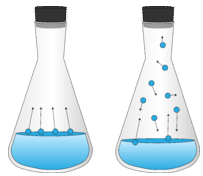13.8: Vapor Pressure
- Page ID
- 53807
\( \newcommand{\vecs}[1]{\overset { \scriptstyle \rightharpoonup} {\mathbf{#1}} } \)
\( \newcommand{\vecd}[1]{\overset{-\!-\!\rightharpoonup}{\vphantom{a}\smash {#1}}} \)
\( \newcommand{\id}{\mathrm{id}}\) \( \newcommand{\Span}{\mathrm{span}}\)
( \newcommand{\kernel}{\mathrm{null}\,}\) \( \newcommand{\range}{\mathrm{range}\,}\)
\( \newcommand{\RealPart}{\mathrm{Re}}\) \( \newcommand{\ImaginaryPart}{\mathrm{Im}}\)
\( \newcommand{\Argument}{\mathrm{Arg}}\) \( \newcommand{\norm}[1]{\| #1 \|}\)
\( \newcommand{\inner}[2]{\langle #1, #2 \rangle}\)
\( \newcommand{\Span}{\mathrm{span}}\)
\( \newcommand{\id}{\mathrm{id}}\)
\( \newcommand{\Span}{\mathrm{span}}\)
\( \newcommand{\kernel}{\mathrm{null}\,}\)
\( \newcommand{\range}{\mathrm{range}\,}\)
\( \newcommand{\RealPart}{\mathrm{Re}}\)
\( \newcommand{\ImaginaryPart}{\mathrm{Im}}\)
\( \newcommand{\Argument}{\mathrm{Arg}}\)
\( \newcommand{\norm}[1]{\| #1 \|}\)
\( \newcommand{\inner}[2]{\langle #1, #2 \rangle}\)
\( \newcommand{\Span}{\mathrm{span}}\) \( \newcommand{\AA}{\unicode[.8,0]{x212B}}\)
\( \newcommand{\vectorA}[1]{\vec{#1}} % arrow\)
\( \newcommand{\vectorAt}[1]{\vec{\text{#1}}} % arrow\)
\( \newcommand{\vectorB}[1]{\overset { \scriptstyle \rightharpoonup} {\mathbf{#1}} } \)
\( \newcommand{\vectorC}[1]{\textbf{#1}} \)
\( \newcommand{\vectorD}[1]{\overrightarrow{#1}} \)
\( \newcommand{\vectorDt}[1]{\overrightarrow{\text{#1}}} \)
\( \newcommand{\vectE}[1]{\overset{-\!-\!\rightharpoonup}{\vphantom{a}\smash{\mathbf {#1}}}} \)
\( \newcommand{\vecs}[1]{\overset { \scriptstyle \rightharpoonup} {\mathbf{#1}} } \)
\( \newcommand{\vecd}[1]{\overset{-\!-\!\rightharpoonup}{\vphantom{a}\smash {#1}}} \)
\(\newcommand{\avec}{\mathbf a}\) \(\newcommand{\bvec}{\mathbf b}\) \(\newcommand{\cvec}{\mathbf c}\) \(\newcommand{\dvec}{\mathbf d}\) \(\newcommand{\dtil}{\widetilde{\mathbf d}}\) \(\newcommand{\evec}{\mathbf e}\) \(\newcommand{\fvec}{\mathbf f}\) \(\newcommand{\nvec}{\mathbf n}\) \(\newcommand{\pvec}{\mathbf p}\) \(\newcommand{\qvec}{\mathbf q}\) \(\newcommand{\svec}{\mathbf s}\) \(\newcommand{\tvec}{\mathbf t}\) \(\newcommand{\uvec}{\mathbf u}\) \(\newcommand{\vvec}{\mathbf v}\) \(\newcommand{\wvec}{\mathbf w}\) \(\newcommand{\xvec}{\mathbf x}\) \(\newcommand{\yvec}{\mathbf y}\) \(\newcommand{\zvec}{\mathbf z}\) \(\newcommand{\rvec}{\mathbf r}\) \(\newcommand{\mvec}{\mathbf m}\) \(\newcommand{\zerovec}{\mathbf 0}\) \(\newcommand{\onevec}{\mathbf 1}\) \(\newcommand{\real}{\mathbb R}\) \(\newcommand{\twovec}[2]{\left[\begin{array}{r}#1 \\ #2 \end{array}\right]}\) \(\newcommand{\ctwovec}[2]{\left[\begin{array}{c}#1 \\ #2 \end{array}\right]}\) \(\newcommand{\threevec}[3]{\left[\begin{array}{r}#1 \\ #2 \\ #3 \end{array}\right]}\) \(\newcommand{\cthreevec}[3]{\left[\begin{array}{c}#1 \\ #2 \\ #3 \end{array}\right]}\) \(\newcommand{\fourvec}[4]{\left[\begin{array}{r}#1 \\ #2 \\ #3 \\ #4 \end{array}\right]}\) \(\newcommand{\cfourvec}[4]{\left[\begin{array}{c}#1 \\ #2 \\ #3 \\ #4 \end{array}\right]}\) \(\newcommand{\fivevec}[5]{\left[\begin{array}{r}#1 \\ #2 \\ #3 \\ #4 \\ #5 \\ \end{array}\right]}\) \(\newcommand{\cfivevec}[5]{\left[\begin{array}{c}#1 \\ #2 \\ #3 \\ #4 \\ #5 \\ \end{array}\right]}\) \(\newcommand{\mattwo}[4]{\left[\begin{array}{rr}#1 \amp #2 \\ #3 \amp #4 \\ \end{array}\right]}\) \(\newcommand{\laspan}[1]{\text{Span}\{#1\}}\) \(\newcommand{\bcal}{\cal B}\) \(\newcommand{\ccal}{\cal C}\) \(\newcommand{\scal}{\cal S}\) \(\newcommand{\wcal}{\cal W}\) \(\newcommand{\ecal}{\cal E}\) \(\newcommand{\coords}[2]{\left\{#1\right\}_{#2}}\) \(\newcommand{\gray}[1]{\color{gray}{#1}}\) \(\newcommand{\lgray}[1]{\color{lightgray}{#1}}\) \(\newcommand{\rank}{\operatorname{rank}}\) \(\newcommand{\row}{\text{Row}}\) \(\newcommand{\col}{\text{Col}}\) \(\renewcommand{\row}{\text{Row}}\) \(\newcommand{\nul}{\text{Nul}}\) \(\newcommand{\var}{\text{Var}}\) \(\newcommand{\corr}{\text{corr}}\) \(\newcommand{\len}[1]{\left|#1\right|}\) \(\newcommand{\bbar}{\overline{\bvec}}\) \(\newcommand{\bhat}{\widehat{\bvec}}\) \(\newcommand{\bperp}{\bvec^\perp}\) \(\newcommand{\xhat}{\widehat{\xvec}}\) \(\newcommand{\vhat}{\widehat{\vvec}}\) \(\newcommand{\uhat}{\widehat{\uvec}}\) \(\newcommand{\what}{\widehat{\wvec}}\) \(\newcommand{\Sighat}{\widehat{\Sigma}}\) \(\newcommand{\lt}{<}\) \(\newcommand{\gt}{>}\) \(\newcommand{\amp}{&}\) \(\definecolor{fillinmathshade}{gray}{0.9}\)What causes this toy to move?
The drinking duck is a toy that many kids (and adults) enjoy playing with. You can see the drinking duck in action in the video below:
The motion of the duck illustrates a physical principle called vapor pressure. As the vapor pressure changes, the liquid in the duck moves up and down, causing the duck to move.
Vapor Pressure
When a partially filled container of liquid is sealed with a stopper, some liquid molecules at the surface evaporate into the vapor phase. However, the vapor molecules cannot escape from the container. So, after a certain amount of time, the space above the liquid reaches a point where it cannot hold any more vapor molecules. Now, some of the vapor molecules condense back into a liquid. The system reaches the point where the rate of evaporation is equal to the rate of condensation (see figure below). This is considered a dynamic equilibrium between the liquid and vapor phase.

A dynamic equilibrium can be illustrated by an equation with a double arrow, meaning that the reaction is occurring in both directions and at the same rate.
\[\ce{H_2O} \left( l \right) \rightleftharpoons \ce{H_2O} \left( g \right)\nonumber \]
The forward direction represents the evaporation process, while the reverse direction represents the condensation process.
Because they cannot escape the container, the vapor molecules above the surface of the liquid exert a pressure on the walls of the container. The vapor pressure is a measure of the pressure (force per unit area) exerted by a gas above a liquid in a sealed container. Vapor pressure is a property of a liquid based on the strength of its intermolecular forces. A liquid with weak intermolecular forces evaporates more easily and has a higher vapor pressure. A liquid with stronger intermolecular forces does not evaporate easily, and thus has a lower vapor pressure. For example, diethyl ether is a nonpolar liquid with weak dispersion forces. Its vapor pressure at \(20^\text{o} \text{C}\) is \(58.96 \: \text{kPa}\). Water is a polar liquid whose molecules are attracted to one another by relatively strong hydrogen bonding. The vapor pressure of water at \(20^\text{o} \text{C}\) is only \(2.33 \: \text{kPa}\), far less than that of diethyl ether.
Vapor Pressure and Temperature
Vapor pressure is dependent upon temperature. When the liquid in a closed container is heated, more molecules escape the liquid phase and evaporate. The greater number of vapor molecules strike the container walls more frequently, resulting in an increase in pressure. The table below shows the temperature dependence of the vapor pressure of three liquids.
| Table \(\PageIndex{1}\): Vapor Pressure (in \(\text{kPa}\) of Three Liquids at Different Temperatures | ||||||
|---|---|---|---|---|---|---|
| \(0^\text{o} \text{C}\) | \(20^\text{o} \text{C}\) | \(40^\text{o} \text{C}\) | \(60^\text{o} \text{C}\) | \(80^\text{o} \text{C}\) | \(100^\text{o} \text{C}\) | |
| Water | 0.61 | 2.33 | 7.37 | 19.92 | 47.34 | 101.33 |
| Ethanol | 1.63 | 5.85 | 18.04 | 47.02 | 108.34 | 225.75 |
| Diethyl Ether | 24.70 | 58.96 | 122.80 | 230.65 | 399.11 | 647.87 |
Notice that the temperature dependence of the vapor pressure is not linear. From \(0^\text{o} \text{C}\) to \(80^\text{o} \text{C}\), the vapor pressure of water increases by \(46.73 \: \text{kPa}\), while it increases by \(53.99 \: \text{kPa}\) in only a span of twenty degrees from \(80^\text{o} \text{C}\) to \(100^\text{o} \text{C}\).
Ever try to boil water on the top of a mountain? Explore the relationship between altitude, vapor pressure and boiling point in this simulation:
Summary
- Vapor pressure is a measure of the pressure exerted by a gas above a liquid in a sealed container.
- Strong intermolecular forces produce a lower rate of evaporation and a lower vapor pressure.
- Weak intermolecular forces produce a higher rate of evaporation and a higher vapor pressure.
- As the temperature increases, the vapor pressure increases.
Review
- Define vapor pressure.
- How do intermolecular forces affect vapor pressure?
- How does temperature affect vapor pressure?

